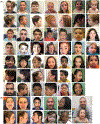Expanding the genotypic and phenotypic spectrum in a diverse cohort of 104 individuals with Wiedemann-Steiner syndrome
- PMID: 33783954
- PMCID: PMC8631250
- DOI: 10.1002/ajmg.a.62124
Expanding the genotypic and phenotypic spectrum in a diverse cohort of 104 individuals with Wiedemann-Steiner syndrome
Erratum in
-
Corrigendum Re: Expanding the genotypic and phenotypic spectrum in a diverse cohort of 104 individuals with Wiedemann-Steiner syndrome. Am J Med Genet A. 2021;185A(6):1649-1665. Doi:10.1002/ajmg.a.62124".Am J Med Genet A. 2022 Mar;188(3):1015. doi: 10.1002/ajmg.a.62567. Epub 2021 Nov 11. Am J Med Genet A. 2022. PMID: 34761848 No abstract available.
Abstract
Wiedemann-Steiner syndrome (WSS) is an autosomal dominant disorder caused by monoallelic variants in KMT2A and characterized by intellectual disability and hypertrichosis. We performed a retrospective, multicenter, observational study of 104 individuals with WSS from five continents to characterize the clinical and molecular spectrum of WSS in diverse populations, to identify physical features that may be more prevalent in White versus Black Indigenous People of Color individuals, to delineate genotype-phenotype correlations, to define developmental milestones, to describe the syndrome through adulthood, and to examine clinicians' differential diagnoses. Sixty-nine of the 82 variants (84%) observed in the study were not previously reported in the literature. Common clinical features identified in the cohort included: developmental delay or intellectual disability (97%), constipation (63.8%), failure to thrive (67.7%), feeding difficulties (66.3%), hypertrichosis cubiti (57%), short stature (57.8%), and vertebral anomalies (46.9%). The median ages at walking and first words were 20 months and 18 months, respectively. Hypotonia was associated with loss of function (LoF) variants, and seizures were associated with non-LoF variants. This study identifies genotype-phenotype correlations as well as race-facial feature associations in an ethnically diverse cohort, and accurately defines developmental trajectories, medical comorbidities, and long-term outcomes in individuals with WSS.
Keywords: KMT2A; MLL1; Wiedemann-Steiner syndrome; hypertrichosis; syndromic intellectual disability; syndromic short stature.
© 2021 Wiley Periodicals LLC.
Conflict of interest statement
CONFLICT OF INTEREST
The authors have no conflicts of interest to declare.
Figures








References
-
- Aoi H, Mizuguchi T, Ceroni JR, Kim VEH, Furquim I, Honjo RS, Iwaki T, Suzuki T, Sekiguchi F, Uchiyama Y, Azuma Y, Hamanaka K, Koshimizu E, Miyatake S, Mitsuhashi S, Takata A, Miyake N, Takeda S, Itakura A, … Matsumoto N (2019). Comprehensive genetic analysis of 57 families with clinically suspected Cornelia de Lange syndrome. Journal of Human Genetics, 89, 584–978. 10.1038/s10038-019-0643-z - DOI - PubMed
-
- Aref-Eshghi E, Kerkhof J, Pedro VP, Barat-Houari M, Ruiz-Pallares N, Andrau JC, Lacombe D, van-Gils J, Fergelot P, Dubourg C, Cormier-Daire V, Rondeau S, Lecoquierre F, Saugier-Veber P, Nicolas G, Lesca G, Chatron N, Sanlaville D, Vitobello A, … Sadikovic B (2020). Evaluation of DNA methylation Episignatures for diagnosis and phenotype correlations in 42 Mendelian neurodevelopmental disorders. American Journal of Human Genetics, 106(3), 356–370. 10.1016/j.ajhg.2020.01.019 - DOI - PMC - PubMed
Publication types
MeSH terms
Substances
Supplementary concepts
Grants and funding
LinkOut - more resources
Full Text Sources
Other Literature Sources
Medical
Research Materials

